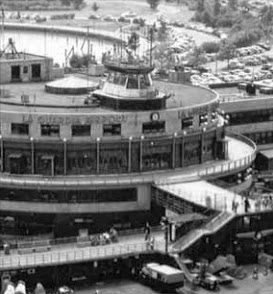Cast your mind back to a time before the AirTrain, a time
when smoking was still allowed on planes and you had to call to book your
ticket because the internet wasn't invented yet. Well, back then, passengers traveling to and
from the airport might have opted to take the JFK Express subway train, a route not too
dissimilar from the ones passengers use today. The service ran from the Queensboro Bridge at 21st Street in
Queens, through Manhattan, all the way to the Howard Beach Station, also in
Queens. While in Manhattan, the train
ran on the B line and once it hit the last stop on the island, West 4th
Street – Washington Square, it ran non-stop. From there, riders took a bus to JFK
Airport. Aside from their lack of graffiti, this new line also differed from its 1970s counterparts in that the fares were collected by conductors on-board and all
cars were fully air-conditioned, making it the shiny, new line.
 |
| This map shows the route followed by the JFK Express, which originated in Queens, ran through Manhattan and then circled back through Queens before reaching the Howard-Beach station. |
This express service, thought to be “the pride of the subwaysystem” when it opened on September 23, 1978, was expected to revolutionize the
city-airport commute by providing the necessary link between the two.[1] A series of commercials aired on TV to advertise the new airport line, which is where it received its famous nickname, The Train to the Plane. However, the success of the Express was
short-lived; it was ultimately cancelled on April 15, 1990, a mere twelve years
after it opened, which begs the question: what went wrong?
The primary reason for discontinuing the subway line was low
ridership. According to the Metropolitan
Transit Authority (MTA), by the time the service was coming to a close, only
3,200 people were using it as opposed to the 4,000 to 5,000 when it first opened.[2] Furthermore, transit officials also claimed
that a majority of passengers were commuters rather than people trying to get
to and from the airport, meaning that overwhelmingly few were paying the full
airport fare and greatly reducing the cost-effectiveness of the project.
 |
| An original JFK Express ticket. Photo courtesy of thejoekorner.com |
Indeed, this decline in usage was indicative of the line’s
decline in popularity. But what was the
underlying cause? The JFK Express was
not really true to its name in that it wasn't an express to the airport. It was not "the Train to the Plane" per se.
Rather, it was a subway service that got passengers pretty close to the
airport, but in the end it was a bus that delivered you to the terminal. As a two-leg journey, it was less appealing
to airport commuters, the second leg a deal breaker for many due to the fuss of
having to transfer and the risk of delays at both points.
 |
| This is a 1987 subway map, showing the JFK Express route (the light blue line). This map predates the addition of the Queensboro stop, which was added two years later. |
However, not everyone was pleased
to hear the news of the route closure – the Port Authority spoke out in
opposition as, in their opinion, the line provided a crucial link between the
airport and the city, one that enabled passengers to travel easily between the
two. Furthermore, the split between the
Port and the MTA ran deeper; while the Transit Authority reasoned that the Port
had not done or invested enough in airport links, the Port suggested that a viable transport route was the responsibility of the state, city
and local transit agencies. In other
words, they both claimed the other was responsible.
 |
| The JFK Express logo on some of the original carriages. Photo courtesy of Wikipedia |
But thirteen years and 1.9 billion
dollars later, it was the Port who took the next step by building an additional
airport transit link, known as the AirTrain.
However, this too was created within the same Port Authority-MTA
dichotomy that divided them over the JFK Express – the AirTrain runs only as
far as Jamaica Station, at which point passengers to leave the Air Train station and walk 200
feet to the subway
or the Long Island Railroad (LIRR).
As such, we can’t help but feel that the AirTrain never really addressed
the main issue facing airport commuters and the one that resulted in the
failure it predecessor, the JFK Express.
It is a problem only really resolved by a one-seat ride.
 |
| JFK's AirTrain connects all JFK terminals with airport facilities and local rail stations. Photo courtesy of PANYNJ |
That said, all is not lost and the
AirTrain may still provide the solution.
While LIRR trains may fit on AirTrain tracks, differences in weight and
voltage prevent them from sharing the rails.
However, as Capital New York pointed out today, the hybrid train would
be able to straddle the two.[3] This new
train would consist of four-car trains, 240 feet in length and have a maximum
capacity of 236 people per train, and, most importantly, it would pick up
passengers at Penn Station and deposit them directly at their terminal.
Here’s to hoping for a 2014 that
includes progress on a real “Train to the Plane” for NYC area airports.
[1]
David E. Pitt, “Transit Agency Wants to End Airport Express,” New York Times, October 22, 1989.
[2]
Pitt, “Transit Agency.”



























